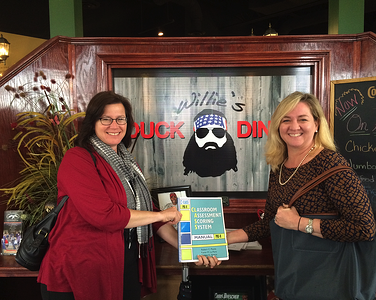
A few months ago I went on a road trip around Louisiana with Sedra Spano and Amy Mountz. And although one of the highlights was definitely visiting the Duck Dynasty Diner …
… another highlight was hearing the question, “So, we did the Introduction to the CLASS Tool and Looking at CLASSrooms online courses, and we were observed by a Certified CLASS Observer. Now what?”
I love this question for so many reasons! I have asked this question myself, and it gets at the heart of what the CLASS is all about: It’s not just about learning about the tool, and it’s not just about being observed. Those are important first steps, but it's really about what you do after an observation that leads to real improvement in the classroom.
As you might recall from my last post, after your observation your observer or coach will often share information about the observation with you. They may explain the things you were really doing well, and maybe some areas where you need some extra information or support.
When I was teaching, I wasn’t observed with the CLASS, but I was observed. Afterwards my mentor shared with me that I was really good at letting students choose what we would talk about that day. She told me that letting them lead the conversation, and even lead the lesson, was really allowing the children to open up and speak. But sometimes, she pointed out, I let the conversation fizzle out after a couple of children spoke, or I wasn’t always continuing the conversation after asking one or two questions.
It was my first year teaching and I was teaching English at the time, so I was really struggling to get the children to speak at all. I didn’t even realize that I was already doing something that was getting language going in my room!
After I talked with my mentor I thought, okay, so what do I do now? How can I really ramp it up and get everyone in this room talking?
A good way to start after your observation is to look up what the CLASS tool has to say about what you are already doing so well, and specific areas where you may need some help from your coach. My coach, for example, gave me some really great ideas of what I could do to increase the use of language in my room. She would come into my room during my English lessons, and afterwards we would talk about some other types of questions I could ask to get conversation going. It also helped me a lot to watch other teachers in my school, or to watch video, like this one in the CLASS Video Library:
Watching videos like this one made it easier for me to understand the changes I could make to give children more opportunities to talk. I knew that if I could get two children talking, I had the ability to get everyone talking. I knew that if I could ask two questions, I could up it to three or four questions. I started by just trying to make one or two little changes a day that I could, and that’s when I really started to see my students grow!
Improving your interactions starts with taking steps on your own after talking with your observer or coach or mentor after an observation. I suggest leaning on what you are already doing really well and challenging yourself to do something everyday that will improve the interactions in your classroom. Use the tools you already have to start the process—like the CLASS Dimensions Guide or the CLASS Video Library. And most importantly, get support from the people around you! I never would have been able to move forward without my mentor and the other teachers in my school who helped me.
